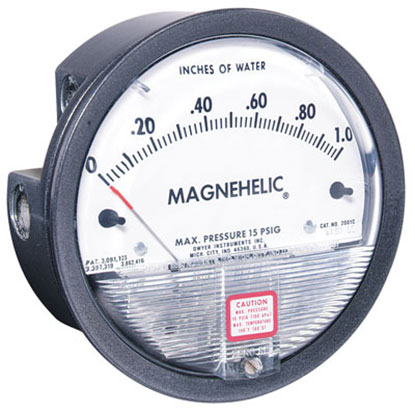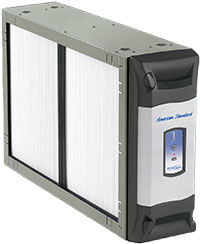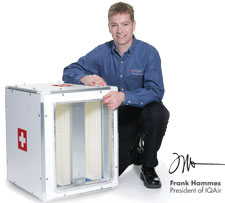 Static Pressure Levels. Static Pressure Levels.
Static pressure in the airflow stream of the ducting and furnace can cause serious problems throughout the operation and life span of an air conditioning system. A proper air conditioning tune up requires the use of a device that measures the amount of airflow through the HVAC system before charging it with Freon.
Static pressure in the airstream of the ducting is merely the amount of vacuum and the amount of pressure exerted by the fan operation. It is the amount of vacuum before the fan and it is pressure after the fan.
Total External Static Pressure (TESP) is the maximum amount of static pressure just prior to the fan (after the filter) and just before the evaporator coil (indoor cooling coil). It is measured with a magnehelic gauge.
Most furnaces are designed to operate at 0.5 inches of water column. This is the amount of pressure that will push water up a column ½ of an inch. It isn’t a lot of pressure. If the ducting is undersized the pressure increases and the amount of air flowing through the air conditioning system slows. We use the magnehelic gauge and a chart to determine the airflow through the system. There are other ways to determine the amount of airflow.
Here is a list of the problems that cause high static pressure and low airflow:
 Undersized air conditioning ducting Undersized air conditioning ducting
 Bends in air conditioning ducts Bends in air conditioning ducts
 Metal fittings in air conditioning ducts Metal fittings in air conditioning ducts
 Poor quality transitions in air conditioning ducts Poor quality transitions in air conditioning ducts
 Dirty air conditioning air filters Dirty air conditioning air filters
 Dirty indoor cooling coils (evaporator coils) Dirty indoor cooling coils (evaporator coils)
What is the problem with lack of airflow?
Each Ton of air requires 400 CFM to produce the cooling BTUS (12,000 BTUS per Ton) that the manufacturer has designated for your system.
1 ½ Tons = 600 CFM (87.5% of capacity = 525 CFM = critical amount of airflow per code)
2 Tons = 800 CFM (87.5% of capacity = 700 CFM = critical amount of airflow per code)
2 ½ Tons = 1000 CFM (87.5% of capacity = 875 CFM = critical amount of airflow per code)
3 Tons = 1200 CFM (87.5% of capacity = 1050 CFM = critical amount of airflow per code)
3 ½ Tons = 1400 CFM (87.5% of capacity = 1225 CFM = critical amount of airflow per code)
4 Tons = 1600 CFM (87.5% of capacity = 1400 CFM = critical amount of airflow per code)
5 Tons = 2000 CFM (87.5% of capacity = 1750 CFM = critical amount of airflow per code)
“Low on Freon” and “Excessive Freon” result in nearly identical Freon pressures on our gauges when the CFM is low. If an air conditioning system is not moving the correct amount of airflow (correct means within 87.5% (350 CFM) of the 400 CFM per Ton Industry Staple) there is a distinct possibility that adding Freon to your system will result in a Freon overcharge. A Freon overcharge, as well as a Freon undercharge, can lead to high electric bills, poor cooling ability and a reduction in the life of the air conditioning system. The most common occurrence that destroys an air conditioning compressor is called a “Liquid Flood-Back” and this means that liquid Freon enters the compressor to be squeezed destroying the compressing chamber in the process. “Liquid Flood-Back” is the reason for more than 90% of compressor failures during the manufacturer’s warranty period.
Read More Testimonials
 Your workers did a fine job on our house. Your workers did a fine job on our house. 
~ Virginia Wayfield
 I would not hesitate to use your company’s service again I would not hesitate to use your company’s service again 
~ K Toley
 We would gladly use your company again in the future. We would gladly use your company again in the future.
~ The Escoto Residence
|



 Static Pressure Levels.
Static Pressure Levels.
